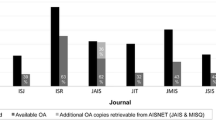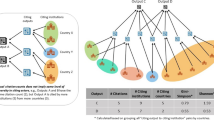Abstract
First, we aim to determine the total amount of scholarly articles freely available on the internet. Second, we aim to prove whether there exists a citation advantage for open publishing. The total scholarly publication output of Norway is indexed in Cristin, the Current Information System in Norway. Based on these data, we searched Google Scholar by either DOIs or titles and denoted a document as open available (OAv), when a link to a full-text was provided. We analysed the extracted data by publishing year, citations, availability and provider. Based on additional information indexed in Cristin, we furthermore analysed the data by year, institution, publisher and discipline. We find that the total share of freely available articles is 68%. Articles not available belong to prestigious publishers such as Elsevier, Springer, Routledge and Universitetsforlaget (the largest Norwegian academic publisher), which may be particularly essential for scholars worldwide. The largest provider, according to Google Scholar’s main link provision, is ResearchGate. In addition, institutional repositories play a major role in posting free article versions. Articles belonging to natural sciences and technology, and medicine and health were more likely to be open than articles belonging to the social sciences and humanities. Their respective OAv-shares are 72, 58 and 55%. We find a clear citation advantage for open publishing; on average, these documents received twice as many citations, indicating that open access is the future in publishing. This study is limited to scholarly articles only. Books and book chapters, which are usual publication formats for the humanities and social sciences, are excluded. Results do therefore not adequately reflect the situation for these disciplines. Furthermore, this study is limited to documents freely available on the internet, independent of the “legal” status of the posted full-text. With the data at hand, we were not able to distinguish between gold, green, hybrid, purely pay-walled and illicitly posted documents. Usually, articles indexed in Web of Science or SCOPUS are objects of investigation. However, these databases do not sufficiently cover the humanities and social sciences, and therefore cannot be representative of the total scholarly article output. This study captures the total article output of a country, independent on discipline and provides new insight into open publishing.






Similar content being viewed by others
References
Antelman, K. (2004). Do open-access articles have a greater research impact? College and Research Libraries, 65(5), 372. Retrieved from http://crl.acrl.org/index.php/crl/article/view/15683.
Archambault, E., Amyot, D., Deschamps, P., Nicol, A., Rebout, L., & Roberge, G. (2013). Proportion of Open Access Peer-Reviewed Papers at the European and World Levels—2004–2011. Science-Metrix (Vol. 1, pp. 495.6505). Retrieved from http://www.science-metrix.com/pdf/SM_EC_OA_Availability_2004-2011.pdf.
Archambault, E., Côté, G., Struck, B., & Voorons, M. (2016). Research impact of paywalled versus open access papers. Science-Metrix and 1 Science. Retrieved from http://www.1science.com/oanumbr.html.
Berlin Declaration on Open Access to Knowledge in the Sciences and Humanities. (2003). Retrieved from https://openaccess.mpg.de/Berlin-Declaration.
Chen, X. (2016). A middle-of-the-road proposal amid the sci-hub controversy: Share “unofficial” copies of articles without embargo, Legally. Publications, 4(4), 29.
European Commisson. (2013). Horizon 2020, Guidelines on Open Access to Scientific Publications and Research Data in Horizon 2020. Retrieved from https://ec.europa.eu/research/participants/data/ref/h2020/grants_manual/hi/oa_pilot/h2020-hi-oa-pilot-guide_en.pdf.
Harnad, S., & Brody, T. (2004). Comparing the impact of open access (OA) vs. non-OA articles in the same journals. D-lib Magazine, 10(6), 9.
Hersh, G., & Plume, A. (2016). Citation metrics and open access: what do we know? Retrieved from https://www.elsevier.com/connect/citation-metrics-and-open-access-what-do-we-know.
Hua, F., Sun, H. Y., Walsh, T., Worthington, H., & Glenny, A. M. (2016). Open access to journal articles in dentistry: Prevalence and citation impact. Journal of Dentistry, 47, 41–48. doi:10.1016/j.jdent.2016.02.005.
Jamali, H. R., & Nabavi, M. (2015). Open access and sources of full-text articles in Google Scholar in different subject fields. Scientometrics, 105(3), 1635–1651. doi:10.1007/s11192-015-1642-2.
Martín-Martín, A., Orduna-Malea, E., Ayllón, J. M., & Delgado López-Cózar, E. (2016). A two-sided academic landscape: Portrait of highly-cited documents in Google Scholar (1950–2013). Revista Española de Documentación Científica, Preprint. doi:10.3989/redc.2016.4.1405.
Mikki, S., Al Ruwehy, H. A., Gjesdal, Ø. L., & Zygmuntowska, M. (accepted by Library Hi Tech). Filter bubbles in interdisciplinary research. A Case study on climate and society.
Ministry of Education and Research. (2013). Meld. St. 18 (2012–2013). Long-term perspectives—Knowledge provides opportunity. Norway: Published under: Stoltenberg’s 2nd Government. Retrieved from https://www.regjeringen.no/en/dokumenter/meld.-st.-18-2012-2013/id716040/.
NFR. (2014). Tilgjengeliggjøring av forskningsdata. Policy for Norges forskningsråd. Retrieved from http://www.forskningsradet.no/servlet/Satellite/?SSURIapptype=BlobServer&blobkey=id&SSURIcontainer=Default&blobwhere=1274506370325&SSURIsession=false&blobheader=application%2Fpdf&ssbinary=true&blobheadername1=Content-Disposition%3A&blobheadervalue1=+attachment%3B+filename%3D9788212033610.pdf&SSURIsscontext=Satellite+Server&blobcol=urldata&blobtable=MungoBlobs#satellitefragment.
Norwegian Research Council. (2014). The Research Council’s Principles for Open Access to Scientific Publications. Retrieved from http://www.forskningsradet.no/servlet/Satellite?blobcol=urldata&blobheader=application%2Fpdf&blobheadername1=Content-Disposition&blobheadervalue1=+attachment%3B+filename%3D%22RCNpolicyOpenAccess.pdf%22&blobkey=id&blobtable=MungoBlobs&blobwhere=1274506495121&ssbinary=true.
NSD. Norwegian Register for Scientific Journals, Series and Publishers. Retrieved from https://dbh.nsd.uib.no/publiseringskanaler/Forside.action?request_locale=en.
Pitol, S. P., & De Groote, S. L. (2014). Google Scholar versions: Do more versions of an article mean greater impact? Library Hi Tech, 32(4), 594–611. doi:10.1108/LHT-05-2014-0039.
Sutton, S. C. (2013). Open access, publisher embargoes, and the voluntary nature of scholarship An analysis. College and Research Libraries News, 74(9), 468–472.
Swan, A. (2010). The Open Access citation advantage: Studies and results to date. Retrieved from https://eprints.soton.ac.uk/268516/.
Universitets-og høgskolerådet. (2004). Vekt på forskning: nytt system for dokumentasjon av vitenskapelig publisering: Innstilling fra faglig og teknisk utvalg til UHR (pp. 83 s.). Retrieved from http://www.uhr.no/documents/Vekt_p__forskning__sluttrapport.pdf.
Acknowledgements
I want to thank my colleagues Hemed Al Ruwehy and Øyvind Gjesdal who kindly provided the data for this study. I also want to thank Lilli Barthel for carefully cleansing the data set retrieved from Google Scholar.
Author information
Authors and Affiliations
Corresponding author
Rights and permissions
About this article
Cite this article
Mikki, S. Scholarly publications beyond pay-walls: increased citation advantage for open publishing. Scientometrics 113, 1529–1538 (2017). https://doi.org/10.1007/s11192-017-2554-0
Received:
Published:
Issue Date:
DOI: https://doi.org/10.1007/s11192-017-2554-0




